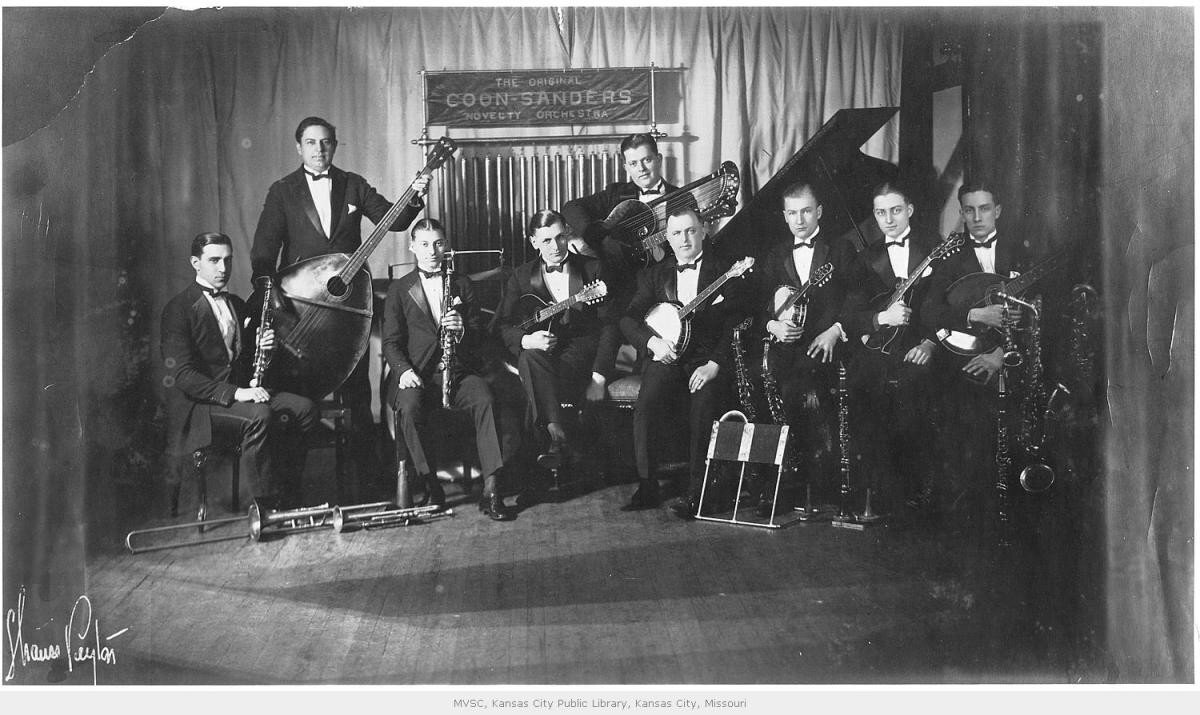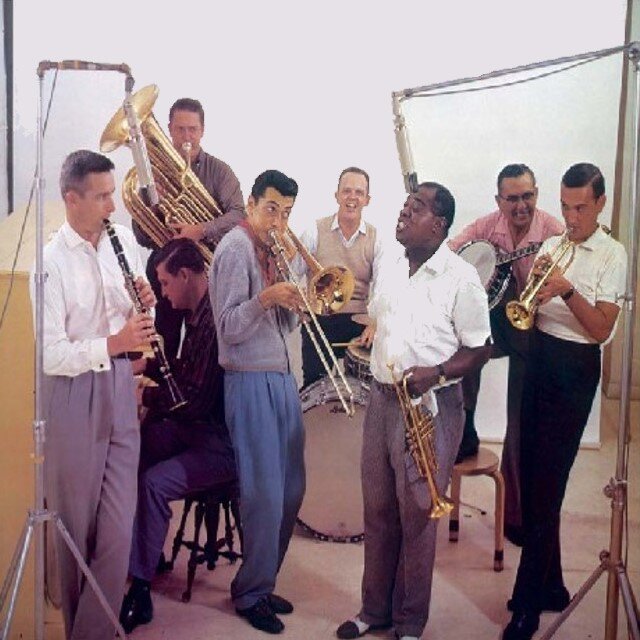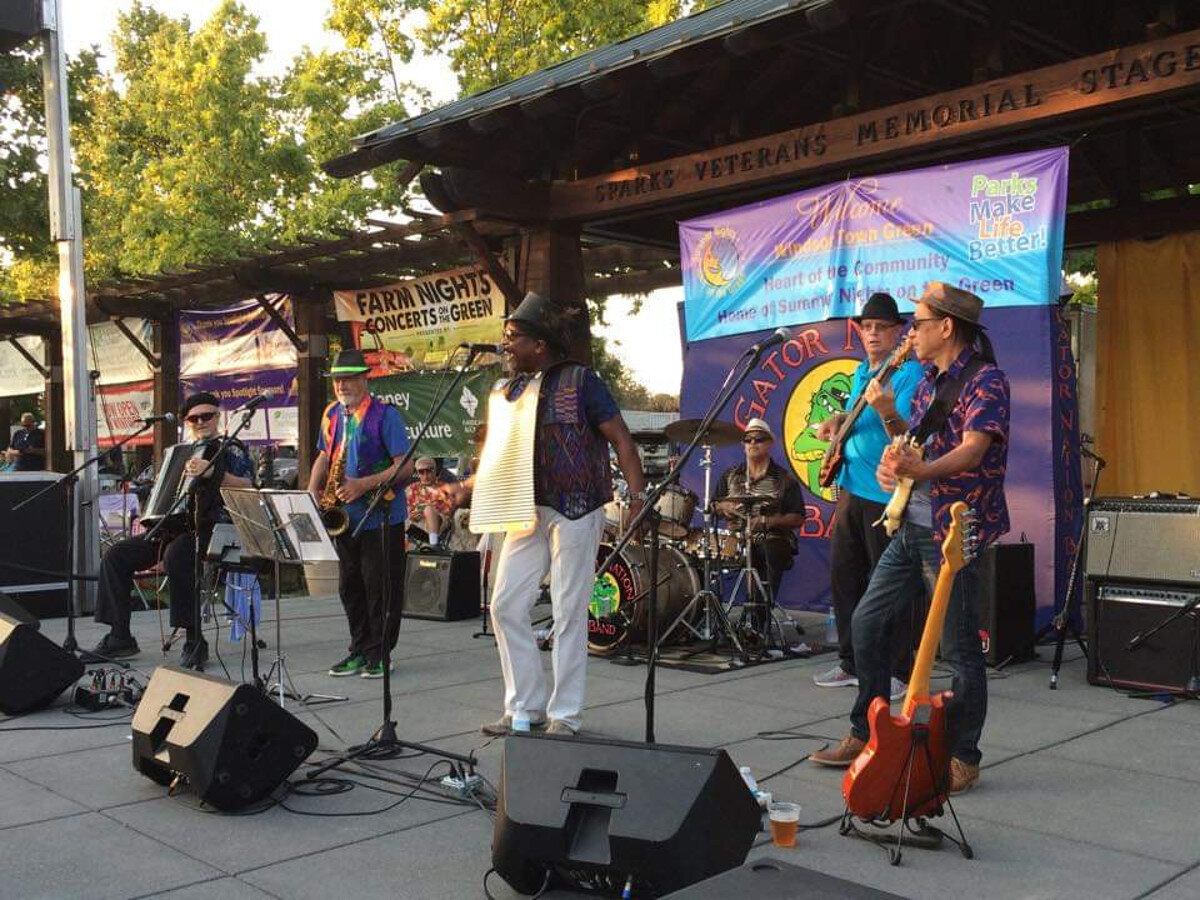 Set forth below is the sixty-seventh “Texas Shout” column. The initial installment of a two-part essay, it first appeared in the November 1995 issue of The American Rag. The text has not been updated.
Set forth below is the sixty-seventh “Texas Shout” column. The initial installment of a two-part essay, it first appeared in the November 1995 issue of The American Rag. The text has not been updated.
In the first “Texas Shout” (published November-December 1989), I argued that “Dixieland” is the preferable generic name for jazz that confines itself to the musical conventions and musical vocabulary employed within the jazz community prior to the development of swing. I touched this subject again in October 1994 while suggesting that, for a variety of reasons, “traditional” and “trad” have not proved to be useful alternative words for that purpose. Today I want to revisit this topic one more time.
Why am I continuing to beat this horse, you groan? Well, anyone who reads this publication has to know that Dixieland has been on life-support for over twenty years. A number of festivals have already pulled the plug by dropping the word “Dixieland” from their names and/or booking popular non-Dixieland acts (country/western, blues, concert-in-the-park, vintage pop, barbershop) to maintain attendance.
In these circumstances, Dixielanders’ first priority, if we’re to keep any presence on the scene at all, has to be recruiting new devotees, both listeners and players, from outside our ranks. We can’t sensibly begin this task if we don’t even agree on the name of the music we’re supposed to be urging those outsiders to seek out.
Specifically, we will not help our cause if I use one term and you use another – or if we both use the same term but mean different things. We will also make life more difficult for ourselves if the term we select is one that has a different or alternative meaning in a non-jazz context.
I don’t want to repeat the October 1994 column, but these problems explain why “traditional” has not proved suitable. First, the standard non-jazz meaning of “traditional” would imply to most people that any jazz over fifty years old, such as the early bop of Charlie Parker, may justifiably claim to be “traditional” (and indeed is considered as such by fans of more recent jazz forms). Second, nobody, inside of Dixieland or out, knows what “traditional jazz” means.
In the latter respect, “traditional” (or “trad”) has never had a clearly defined, well understood, widely accepted, precise meaning within the Dixieland community. As a result, each Dixielander using “trad” or “traditional” has his/her own personal idea of what is meant by the term, a situation that exacerbates the confusion, fractionalization and infighting that (1) prevents Dixielanders from acting together in our own best interests and (2) makes it nearly impossible to use the term effectively to entice outsiders.
The same difficulties arise with words like “classic.” Whether or not you like bop, you can’t reasonably deny that many of Charlie Parker’s bop performances are “classic” jazz rides in every sense of the word. The larger jazz community simply isn’t going to let Dixielanders appropriate words like “classic” so that the only “classic jazz” renditions henceforth will be Dixieland.
We need a word that refers only to our music and which will be easily recognized as excluding swing, bop and later jazz forms. Fortunately, we have one. It is “Dixieland.”
Whether or not a person likes Dixieland jazz, or whether or not a person likes the term “Dixieland,” I think that most people who hear the word and attach any meaning to it at all associate it with music that comes out of the 1920s. They may not recognize it as jazz, but they usually don’t confuse it with the output of Benny Goodman, Dizzy Gillespie, the Beatles, Elvis, Maria Callas, Eddy Arnold, etc.
That’s a great start for us. We should build on it.
Nevertheless, I have discovered that there is a strong resistance, an irrational one in my opinion, to the term “Dixieland” in some quarters and an equally strong reluctance to give up the sloshy term “traditional.” Thus, I want to confront directly some of the claims I’ve heard, not specifically addressed in my two prior columns, when I ask the question “What’s wrong with ‘Dixieland’?”
One TAR commentator wrote that he was comfortable enough with “Dixieland” in general, but had difficulty believing that the big band style of the twenties fits under that term. I can understand where he’s coming from.
Viewing with the 20/20 hindsight of the 1990s, we see big band jazz as part of a continuum that peaked with the big swing bands in the thirties and continued into progressive and more advanced big band jazz forms. We now tend to think of the “big” jazz bands of the twenties (which usually had about ten pieces) as the opening end of that largely non-Dixieland spectrum. Thus, some of us may have trouble accepting the fact that those beginnings of big band jazz are really Dixieland outfits when considered in terms of the music they played.
The big band jazz style of the twenties, popularly known by the somewhat misleading term “hot dance,” was the subject of my third “Texas Shout,” published in the February 1990 issue. That column says, among other things, that hot dance is a form of jazz in which the musicians (1) confine themselves to the musical vocabulary and musical conventions that existed in the jazz community prior to the development of swing and (2) codify those musical devices in head or written arrangements for sections and ensembles, so that only the soloists are given a spontaneous choice of which notes to play.

If one keeps that definition in mind, I think it’s easier to recognize that hot dance is, indeed, a Dixieland style. If a band is playing licks that characterize it as a Dixieland band, the type of music it’s playing doesn’t change just because those licks may be written down or memorized so that they can be exactly replicated. Similarly, while hot dance bands tend to be (but need not necessarily be) larger than the typical Dixieland combo, it should be clear that the type of music being played doesn’t change simply and solely because the size of the band changes, as long as everyone continues to use the same musical vocabulary and conventions.
Remember also that, as I have said many times in these pages, though most Dixieland bands employ a lot of improvisation, improvisation is not a sine qua non of Dixieland or even of jazz. There have been, and will continue to be, many performances easily recognizable as jazz (including Dixieland) which are fully arranged throughout. Some “hot dance” rides fit that description, but are not thereby disqualified from being a part of Dixieland jazz.
Hoping that the foregoing explanation helps you over the hurdle of classifying hot dance as, in fact, one of the seven Dixieland styles, let’s briefly consider a possible red herring in the discussion of the desirability of “Dixieland.” I refer to the fact that not long ago the Sacramento Jazz Jubilee dropped the word “Dixieland” from its name. Other festivals may have followed suit, but offhand, I can’t recall any.
I bring up this point just to head off any claim that Sacto is opposed to the term “Dixieland” as such. The change was made, as the festival’s publicity made crystal clear, because the festival’s presentations became so broad-based that Sacto could no longer accurately be called a “Dixieland” festival or be described by any of the other words that are considered synonymous with “Dixieland.”
A glance at the headliners spotlighted at the front of the festival’s program book in recent years reveals that the top acts at Sacto, the ones that have been drawing the largest crowds and which have been getting expanded festival time, are vintage pop artists (like Kay Starr), blues, zydeco, country/western, Latin, barbershop, big-band dance and other similar forms of music; none of these is even jazz, much less Dixieland. The general public, the audience that Sacto is trying to attract, wouldn’t expect to find such acts at a “Dixieland” festival, so naturally the word was dropped from the festival’s title.
Anyway, to the extent that Sacto or other festivals have removed “Dixieland” from their names, I do not see this action as being indicative of a groundswell of aversion to the word itself among producers. It is instead a realistic reaction to the fact that our music, by whatever name, doesn’t do much anymore to draw very large crowds.

By the way, we’re very fortunate that Sacto continues to be run by the local Dixieland club members. These good people, to their credit, have continued to proclaim their commitment to our music and support that commitment by hiring annually, along with the other artists, more Dixieland bands than any other U.S. festival.
If Sacto ever gets turned over to, say, the Sacramento Chamber Of Commerce or tourist bureau, I have no doubt it would (1) drop the word “Jazz” from the festival’s title, re-christening it the “Sacramento Jubilee,” (2) get rid of about 20 of the least popular Dixieland bands, replacing them with regional combos that play 1950s/early 1960s rock or R&B, (3) salt away the remaining Dixieland bands into a few Dixieland-only sites and (4) sit back and watch attendance increase. Let’s hope that Roger Krum and his wonderful staff remain on the job for a good long time.
The following update was added when the essay was reprinted in the December 2003 issue of The American Rag.
As a validation of the points made in the closing paragraphs above, I cite Sacramento’s elaborate eight-page giveaway newspaper promoting the 2002 Jubilee. By my count of the 100-plus acts listed therein on the program, the festival hired some 35 Dixieland bands for that weekend (excluding youth bands); about 16 of them I consider top-rank, headline combos that I would be happy to see live and which I expect would entice any Dixielander disposed to travel to hear the music. Sacto thereby confirmed the producers’ long-standing heavy commitment to Dixieland, making Dixieland units the largest segment, percentage-wise, of its total lineup and placing it second to none in the number of first-call Dixieland bands on the bill.
However, Dixieland jazz is referred to just three times in this extensive brochure. I quote these references in their entirety:

From Page 1: “And if you think the Jubilee is about having to drag yourself to Old Sacramento to hear a bunch of moldy figs make 100-year old mistakes, think again. We got the Platters and several veteran performers from the Lawrence Welk television shows as headliners. And we got blues, we got swing, we got barbershop, we got zydeco, we got combos, we got washboards, we got rhythm and blues, we got jug bands and banjo bands and special performances for the kids. And, well, heck, we have Dixieland as well.”
From Page 7 (both references): “‘You’re going to a Dixieland festival? Isn’t that music, well … awfully corny?’ Indeed, what is a gal raised on the Beatles, the Beach Boys and Motown doing at a trad jazz festival?”
“Variety, variety, variety. No matter what, you just know you’re not going to like that banjo-washboard-tinkly piano music? Not a problem. Blues, western swing, hot jazz, zydeco, big band; it’s all part of the Jubilee soundtrack. …”
These three references, coming from a festival that’s probably spending more money to present Dixieland than any of the other kinds of music mentioned therein, are nevertheless decidedly negative in tone. What’s going on here? Here’s my guess.
Sacto is big business, the biggest festival of its kind in the U.S. It properly pays considerable attention to the kind of marketing it needs to maintain, and hopefully increase, its paid attendance of 100,000-plus.
The above-quoted sections of the 2002 brochure suggest to me that Sacto recognizes that (1) virtually all of the hard-core Dixieland fans likely to attend the Jubilee already know that Sacto is the place to find more of their favorite music than anywhere else and (2) among the remainder of the population, the prospect of hearing 1920s-style jazz probably drives away more potential attendees these days than it attracts. Thus, the Jubilee decided to bend over backwards, in promotions aimed at a general audience, to erase its image of being principally a Dixieland event.
In my view, much as I personally love Dixieland, this is clearly the right long-term strategy for the Jubilee’s financial success. I have to compliment Roger Krum and his staff for figuring out a way to implement it without cutting back on the festival’s substantial support for Dixieland.
Part 2
 Want to read ahead? Buy the book!
Want to read ahead? Buy the book!
The full run of “Texas Shout” has been collected into a lavishly illustrated trade paperback entitled Texas Shout: How Dixieland Jazz Works. This book is available @ $20.00 plus $2.95 shipping from Tex Wyndham, On request, Tex will autograph the book and add a personalized note (be sure to tell him to whom the note should be addressed).
Tex Wyndham’s 3 CD Guide to Dixieland with music and commentary is available for $20 plus $2.95 shipping. The separate CD, A History of Ragtime: Tex Wyndham Live At Santa Rosa, is available for $13.00 plus $2.00 shipping. On request, Tex will autograph the inner sleeve and add a personalized note (be sure to tell him to whom the note should be addressed).
Send payment to Tex Wyndham, P.O. Box 831, Mendenhall, PA 19357, Phone (610) 388-6330.
Note: All links, pictures, videos or graphics accompanying the Shouts were added at the discretion of the Syncopated Times editorial staff. They did not accompany the original columns and do not necessarily reflect the opinion of Tex Wyndham.
From roughly 1970-2010, Tex Wyndham was: (1) one of the best-known revivalist Dixieland jazz musicians in the US, as cornetist, pianist and bandleader, (2) one of the best-known ragtime pianists in the US, and (3) one of the most respected critics in the US of Dixieland jazz, ragtime, and related music. He is the only person about whom all three of those statements can be made.


















